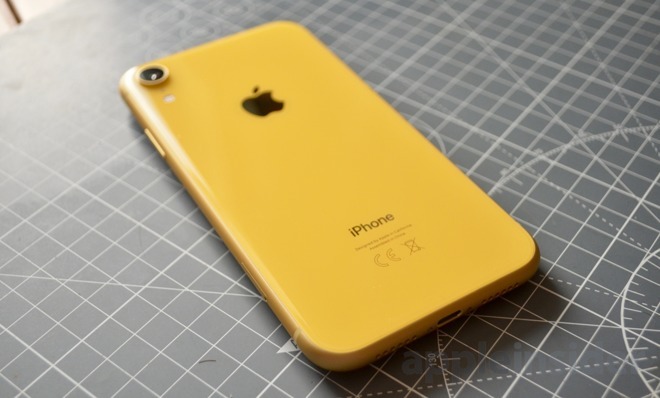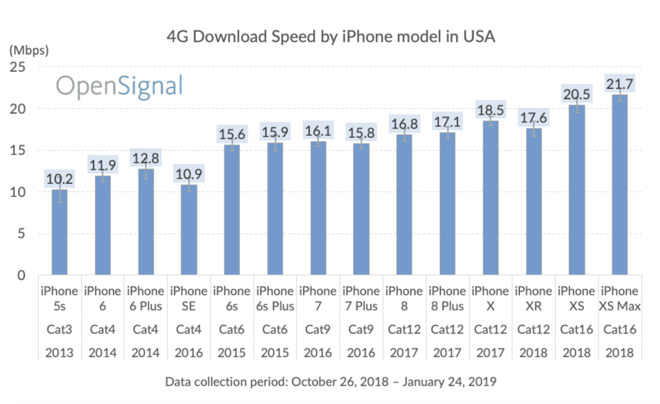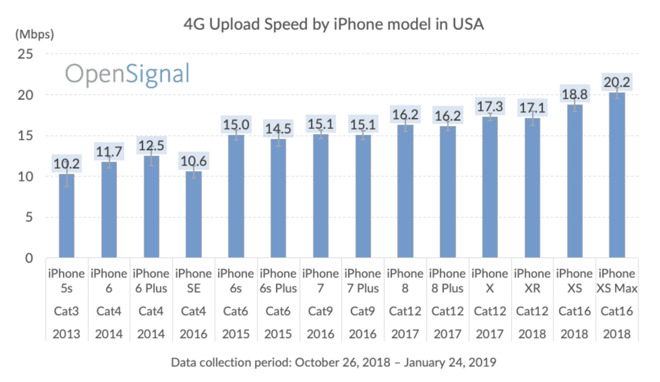Real-world LTE speed has doubled since iPhone 5s, is big reason to upgrade
Owners of older iPhone models should upgrade to newer versions if they want to benefit from faster cellular speeds, research from OpenSignal advises, with the iPhone 5s seemingly only capable of half of the network performance of the iPhone XS and iPhone XS Max due to the use of older communications technologies.

The iPhone XR doesn't use the same LTE Category support as the iPhone XS and iPhone XS Max, making it slower on mobile networks
The full report by OpenReach expands on data revealed yesterday that the iPhone XS and iPhone XS Max are nearly 26 percent faster than all other models released between 2015 and 2017. On closer inspection of the data, it seems the adoption of new LTE Category numbers over the years makes a big difference in the amount of data an iPhone can consume at a time.
OpenSignal uses data from a variety of iPhones tested across the United States over multiple carriers, between October 26 and January 24. While 3G data could have been analyzed, the report solely looks into the use of 4G signal.
According to a chart of models from the iPhone 5s to the current generation of models, there is seemingly a major jump in connection speeds from the use of Cat 3 in the iPhone 5s and Cat 4 in the iPhone 6, 6 Plus, and iPhone SE, to later releases. While those that had Cat 4 LTE reached download speeds of up to 12.8Mbps, the iPhone 6S and Plus' support of Category 6 brought speeds up to 15.6Mbps and 15.9Mbps respectively.

Speeds did not majorly change until the introduction of Cat 12 support in the iPhone 8, iPhone 8 Plus, and iPhone X, with the technology retained for use in the iPhone XR. Both the iPhone XS and iPhone XS Max's speeds above 20Mbps are partly due to their support of Category 16 LTE communications.
According to OpenSignal, smartphones using older 4G standards, namely those with lower LTE Category numbers, are incapable of supporting advanced techniques used by carriers to boost bandwidth, such as carrier aggregation. In the case of the LTE Category 16 devices, their modems are designed to improve the efficiency of network performance, which helps both with increasing speed but also keeping the connection stable.
It is also noted that, while the physically larger models have more room for high-grade antennas to be used, the Plus models of each generation have comparable connectivity to their non-Plus counterparts.

A similar grouping of speed increases is also seen when upload speeds are examined. Newer devices tend to offer greater upload speeds than older models, with the iPhone XS Max at 20.2Mbps almost doubling the iPhone 5s' 10.2Mbps.
"With both 4G download and upload experience we see a difference between the iPhone XR and the iPhone XS," notes OpenSignal. "This highlights how the choice of modem, chipset, and antenna design influence the mobile network experience that consumers receive."
It is probable that the next generation of iPhones won't see as much of a speed boost as observed with the iPhone XS and XS Max. Apple typically lags behind the curve in terms of adopting communications standards, and the first iPhones to use the upcoming 5G networks isn't expected until 2020 at the earliest.
Carriers in the US have started to roll out their 5G mobile networks, which are expected to provide a major jump in connection speeds. Again, while there are some areas where some people can legitimately use 5G signal, they are currently limited to specific situations, with general coverage of standards-based 5G signal unlikely to make an impact until the end of 2019 or even 2020.

The iPhone XR doesn't use the same LTE Category support as the iPhone XS and iPhone XS Max, making it slower on mobile networks
The full report by OpenReach expands on data revealed yesterday that the iPhone XS and iPhone XS Max are nearly 26 percent faster than all other models released between 2015 and 2017. On closer inspection of the data, it seems the adoption of new LTE Category numbers over the years makes a big difference in the amount of data an iPhone can consume at a time.
OpenSignal uses data from a variety of iPhones tested across the United States over multiple carriers, between October 26 and January 24. While 3G data could have been analyzed, the report solely looks into the use of 4G signal.
According to a chart of models from the iPhone 5s to the current generation of models, there is seemingly a major jump in connection speeds from the use of Cat 3 in the iPhone 5s and Cat 4 in the iPhone 6, 6 Plus, and iPhone SE, to later releases. While those that had Cat 4 LTE reached download speeds of up to 12.8Mbps, the iPhone 6S and Plus' support of Category 6 brought speeds up to 15.6Mbps and 15.9Mbps respectively.

Speeds did not majorly change until the introduction of Cat 12 support in the iPhone 8, iPhone 8 Plus, and iPhone X, with the technology retained for use in the iPhone XR. Both the iPhone XS and iPhone XS Max's speeds above 20Mbps are partly due to their support of Category 16 LTE communications.
According to OpenSignal, smartphones using older 4G standards, namely those with lower LTE Category numbers, are incapable of supporting advanced techniques used by carriers to boost bandwidth, such as carrier aggregation. In the case of the LTE Category 16 devices, their modems are designed to improve the efficiency of network performance, which helps both with increasing speed but also keeping the connection stable.
It is also noted that, while the physically larger models have more room for high-grade antennas to be used, the Plus models of each generation have comparable connectivity to their non-Plus counterparts.

A similar grouping of speed increases is also seen when upload speeds are examined. Newer devices tend to offer greater upload speeds than older models, with the iPhone XS Max at 20.2Mbps almost doubling the iPhone 5s' 10.2Mbps.
"With both 4G download and upload experience we see a difference between the iPhone XR and the iPhone XS," notes OpenSignal. "This highlights how the choice of modem, chipset, and antenna design influence the mobile network experience that consumers receive."
It is probable that the next generation of iPhones won't see as much of a speed boost as observed with the iPhone XS and XS Max. Apple typically lags behind the curve in terms of adopting communications standards, and the first iPhones to use the upcoming 5G networks isn't expected until 2020 at the earliest.
Carriers in the US have started to roll out their 5G mobile networks, which are expected to provide a major jump in connection speeds. Again, while there are some areas where some people can legitimately use 5G signal, they are currently limited to specific situations, with general coverage of standards-based 5G signal unlikely to make an impact until the end of 2019 or even 2020.

Comments
The reality is my iPhone 6s speeds fluctuates enormously, and it has nothing to do with my device.
In the exact same location my 6s can get anywhere from 75Mbs to less than 10Mbs, so I know the device is “capable” of at least 75Mbs on the network.
I used to get closer to the 75Mbs every time I ran the test, but then T-mobile announced their merger with Sprint. The problem isn’t my phone, it’s the network, interference, congestion, etc.
If I upgrade 6s to the latest phone, I’ll see incremental improvement but not enough to justify the cost. If bandwidth was the concern, I’d see greater improvement (for the cash) switching Verizon.
I’ll replace my 6s when 5G is rolled out in my area. That’s when I’ll see significant improvement...
Where I see a problem is in dense urban areas- I live in the burbs. In the city, there are a lot more phones drawing on every tower and the speeds are nowhere near that even when you are close and unimpeded.
The real improvement in mobile internet has been away from the urban centers and Interstate corridors. I drive to a rural hospital on weekends and the quality of coverage is so much better than it used to be there is no scale I can think of to apply to it. There are 3 different routes I can take depending upon construction and weather. 2 of them have flawless connectivity and the 3rd is much better but still has a stretch of very marginal connectivity, but it is a very rural area in the middle of nowhere.
However, I should clarify that I’m in our warehouse at work which gets poor reception. I have hit 100 several times in areas with better reception. No complaints here with my speeds and my apparently shitty Intel modem.
Faster cellular is not at all in my consideration to upgrade my 6S+, unless you consider it might discourage me knowing 5g networks are a year or so away and that is a reason to delay.